India
Differences in "Shakti"
Shakti, which can be defined as spiritual force, movement, energy, presence, transmission, etc., is not just one thing - it has various signatures and effects, depending on the lineage, teacher, area, etc. A most common form of shakti in the Hindu/Samkya/Yoga sphere is what can be loosely defined as "goddesslike" energy, which makes one joyful, happy, elevated - one karmic burden is (temporarily) eased, and one feels released, and it promotes unconditional love. This is simply is one type of spiritual force, which works through specific channels in the body/mind. This may be classified as part of the "vertical" path, the ascent of energies in the body/mind to the higher chakras, heart, third eye, crown chaka along a certain path in the body.
But my experience of this "vertical" path is that it is a long, long path, and whenever I've experienced the transmission of this kind of shakti, and I've spent enough time of my life immersed in this field, in meditation, group 'satsang' etc. to know that it has blissful effects, but its effects _always_ disappeared. I was never fundamentally changed by this 'vertical path', and even more, I felt like it was simply another form of energy that I was becoming addicted to - just another, less dangerous, extension of a drug experience.
The shakti, or energy of the vertical path is associated with the rising of 'kundalini' energy _up_, but there is another shakti, that my old teacher Love Ananda/Adi Da called the shakti of 'understanding', which works differently. Advaita Vedanta, started by Shankara, and certainly popularized by Ramana Maharshi, with his offering of "Who Am I" is associated with a practice of enquiry, "questioning" into the nature of self and existence. It is not necessarily blissful in the way the 'vertical path' is, but it works to bring a person into recognition of his/her fundamental condition.
It promotes realization and a freedom that I've personally never found going "in and up". And this form of shakti is (at least in the Ramana and Adi Da camps) associated with a point on the right side of the heart, as opposed to the more common heart "chakra". There is a "directness" to this kind of shakti that is not found in the vertical/kundalini type.
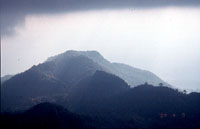 Anyway, there's a whole lot more that
can be said about it, but the point is
that both Ramana and Adi Da claim to have some
association with Lord Shiva - Ramana
spent his entire life around Arunachala
mountain, which is celebrated as a
form of Lord Shiva. And certainly my
experience with Adi Da is that he is
very Shiva-like is his transmision
(the other crazy stuff that goes on
in his community aside). So this
association with Shiva is a reason
why I am interested in visiting Shiva
temples here in India. And to call
it shakti is not necessarily correct,
since shakti is associated with the
goddess, a feminine aspect of spirituality
and this is Shiva-like, a masculine
and impersonal aspect. Shakti is associated
with movement, the "dance" of form, and
Shiva is (initially) the corpse, the Divine
Ground, the context upon which the Goddess
and all form dances upon. But eventually
Shiva also dances (Shiva Nataraj). This
Divine and really groundless Ground
cannot be found or seen, but in Realization
it is directly Intuited, Apprehended,
Cognized spontaneously and immediately.
I capitalize to indicate a more profound
type of event than ordinary intuition, etc.
It has no "qualities" but all qualities
are found in it, and the Buddhist term
of Emptiness or Openness is another way
to describe it (though some Buddhists would
wring my neck for making such an
association!).
Anyway, there's a whole lot more that
can be said about it, but the point is
that both Ramana and Adi Da claim to have some
association with Lord Shiva - Ramana
spent his entire life around Arunachala
mountain, which is celebrated as a
form of Lord Shiva. And certainly my
experience with Adi Da is that he is
very Shiva-like is his transmision
(the other crazy stuff that goes on
in his community aside). So this
association with Shiva is a reason
why I am interested in visiting Shiva
temples here in India. And to call
it shakti is not necessarily correct,
since shakti is associated with the
goddess, a feminine aspect of spirituality
and this is Shiva-like, a masculine
and impersonal aspect. Shakti is associated
with movement, the "dance" of form, and
Shiva is (initially) the corpse, the Divine
Ground, the context upon which the Goddess
and all form dances upon. But eventually
Shiva also dances (Shiva Nataraj). This
Divine and really groundless Ground
cannot be found or seen, but in Realization
it is directly Intuited, Apprehended,
Cognized spontaneously and immediately.
I capitalize to indicate a more profound
type of event than ordinary intuition, etc.
It has no "qualities" but all qualities
are found in it, and the Buddhist term
of Emptiness or Openness is another way
to describe it (though some Buddhists would
wring my neck for making such an
association!).
Back to Nilkanth
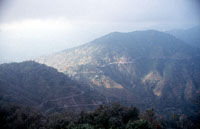 But what I've experienced here at Nilkanth is a
force that is "opened eyes", it is not relaxing,
but simply a pure force of presence that
shouts "Wake Up!". It is a shock to
the system that can bring you to
another level of View, a direct path
to realization, and (I believe) this
is what Shiva based paths are about,
such as Kashmir Shaivism, which speaks
about the use of 'shock' to elevate one's
consciousness to a greater state. You suddenly
stand as the Witness and then beyond -
in other words, you may not necessarily
have to withdraw from sense experience
for this to happen, as in the Ramana
"lineage".
But what I've experienced here at Nilkanth is a
force that is "opened eyes", it is not relaxing,
but simply a pure force of presence that
shouts "Wake Up!". It is a shock to
the system that can bring you to
another level of View, a direct path
to realization, and (I believe) this
is what Shiva based paths are about,
such as Kashmir Shaivism, which speaks
about the use of 'shock' to elevate one's
consciousness to a greater state. You suddenly
stand as the Witness and then beyond -
in other words, you may not necessarily
have to withdraw from sense experience
for this to happen, as in the Ramana
"lineage".
An analogy is this: all of existence, every point in physical or subtle space has a certain 'voltage', but what we see as differences in things, physical objects, emotions, thoughts, ideas, are differences in amplitude and frequency. Higher 'vibes' have higher frequencies, more evil vibes have lower frequencies, etc. We really can't 'feel' the voltage, because everything about us is at that voltage - we swim in it, the voltage of existence. But real effective Gurus and places like Nilkanth up the voltage to 220 or 440 and more, bringing a force that intensifies existence and promotes real spiritual revelation and realization. It can really make a difference. It is concentrated Existence, capital E, a "divine" portal.
So it makes me happy to find a place like Nilkanth, though it is a real bumpy ride to get there. And I don't know if it will stay that way if it gets more popular or whatever, and certainly it may have been just a right moment for me (and as they say, your mileage may vary if you get a chance to go there). But if you are ever in Uttar Pradesh, India, I most certainly recommend you go there.
After I left the temple, I walked around the area, feeling fortunate to have found this place, and I purchased a few items to remember Nilkanth, a mala and a cheap little cobra ring that I still wear.
I also got lost going back to the taxi, walking into an area where women were bathing, another major oops! And when I found the taxi, nearly in tears, I said to Kuku, "wow, maha shakti!". And he retorted with a thick Hindi accent," Yase, verrrri oli!".
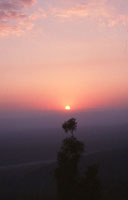 So we returned the same way we came,
down the bumpy road, but funny,
the road back seemed to take a
much shorter time. We arrived back
in the Swarg Ashram area of
Rishikesh. Kuku asked "lunch?", and
I said yes. He drops me off in this
lane lined with little food and
souvenir vendors - this will be
my first experience with an outside
food vendor, boldly going where my
digestive tract has not gone before.
So we returned the same way we came,
down the bumpy road, but funny,
the road back seemed to take a
much shorter time. We arrived back
in the Swarg Ashram area of
Rishikesh. Kuku asked "lunch?", and
I said yes. He drops me off in this
lane lined with little food and
souvenir vendors - this will be
my first experience with an outside
food vendor, boldly going where my
digestive tract has not gone before.
I picked a small vendor, a young boy selling little potato-like pancakes and vegetables. So I stood at a wall eating this lunch, which was great, with many people passing by, some saying hello, some coming up and shaking my hand, asking me where I am from and trying their English on me, which apparently gives them a real kick that they can communicate effectively with me. Across the way, a sadhu that I saw at Nilkanth, with matted hair and saffron robes, sat down at a vendor booth across the lane with another older sadhu. Recognizing that we saw each other at Nilkanth, we smiled at each other.
Kunjapuri Mountaintop Durga Temple
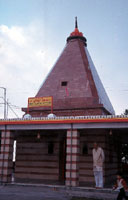 After Nilkanth, I couldn't possibly
see Kunjapuri as being anything but a
bit of a disappointment. The road to
Kunjapuri is paved and a whole lot
better, and I got my first look at
the Himalayan highlands past the
mountains surrounding Rishikesh.
However, it was a bit cloudy to
the north, so I couldn't see the big
boys to the north. The Kunjapuri
temple requires walkig about 500
to 1000 steps up a brightly colored
set of concrete stairs before getting
to the top, and when you get there,
you have a 360 degree view of the
surrounding countryside. It reminded
me of the view from Mt. Tamalpais
in Marin County, Ca, but somewhat
higher. The humidity and pollution
in the air detracted from the view,
but the cool air was a nice respite
from the heat and humidity of
downtown Rishikesh.
After Nilkanth, I couldn't possibly
see Kunjapuri as being anything but a
bit of a disappointment. The road to
Kunjapuri is paved and a whole lot
better, and I got my first look at
the Himalayan highlands past the
mountains surrounding Rishikesh.
However, it was a bit cloudy to
the north, so I couldn't see the big
boys to the north. The Kunjapuri
temple requires walkig about 500
to 1000 steps up a brightly colored
set of concrete stairs before getting
to the top, and when you get there,
you have a 360 degree view of the
surrounding countryside. It reminded
me of the view from Mt. Tamalpais
in Marin County, Ca, but somewhat
higher. The humidity and pollution
in the air detracted from the view,
but the cool air was a nice respite
from the heat and humidity of
downtown Rishikesh.
When I arrive at a temple, I usually examine the natives to see what they do, in order to not do some major faux pas and get thrown out on my ass. I followed a family who also was at Nilkanth in the morning, and made an offering a the Durga temple, another small mountain structure. Both Nilkanth and Kunjapuri have incredibly intricate roofs, apparently a custom of many temples in India. Kunjapuri also has a big Shiva or Krishna blue statue, but to keep people from touching it, it has a cage around it, which seems like a Shiva/Krishna zoo piece.
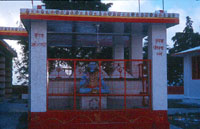 Don't get me wrong, if you're interested
in visiting unique and beautiful temples,
Kunjapuri is definitely worth going to
see, especially since you also get
a great view of the area. But even
though it did have shakti energy, it
just wasn't Nilkanth. After I sat for a
while, the priest/pujarist asked me
where I was from. I told him California,
USA, but still feel weird talking inside
temple chambers.
Don't get me wrong, if you're interested
in visiting unique and beautiful temples,
Kunjapuri is definitely worth going to
see, especially since you also get
a great view of the area. But even
though it did have shakti energy, it
just wasn't Nilkanth. After I sat for a
while, the priest/pujarist asked me
where I was from. I told him California,
USA, but still feel weird talking inside
temple chambers.
On the way back down, Kuku was flipping radio channels and picked up a Delhi jazz station in English. It was trying to be cool, with the DJ talking in a low, sexy voice like they try to do on 'cool' FM stations. The DJ proceeded to play a new rendition of "Bewitched, Bothered and Bewildered" (don't know if that is the right title), part of the song goes, "I'm wild again, beguiled again...bewitched bothered and bewildered".
After visiting two temples at the heart of Hinduism, it was like a major culture mind-scramble. It was like, "man this does not compute!" - such a ostensibly western song in Rishikesh. It actually made me a bit homesick, weirdly, for my parents, since that song I believe comes out of their generation. I also felt how little their lives are in comparison to mine, their opting for a total bow to safety, security and cultural norms. But I felt my love for them and hoped that they were OK. Like many people of my generation and age, it is at the time when we can get the "call", that one of our parents has passed away, and this certainly came up for me. I wouldn't know for a week at a time, when I would call my wife Annie or contact her via email.
I came back into Rishikesh too late to go to Gangarati, but I didn't feel bad about it at all. I went to my favorite place again, Neelam's restaurant, and then sent out the previous posting of my travelogue, while parades were going through the streets of the Triveni Ghat area, a wild and party-like atmosphere. I wondered if this is the way it is every night after Gangarati.
 Back |
 Rishikesh, con't. |
|
|
Page 12. |
||
